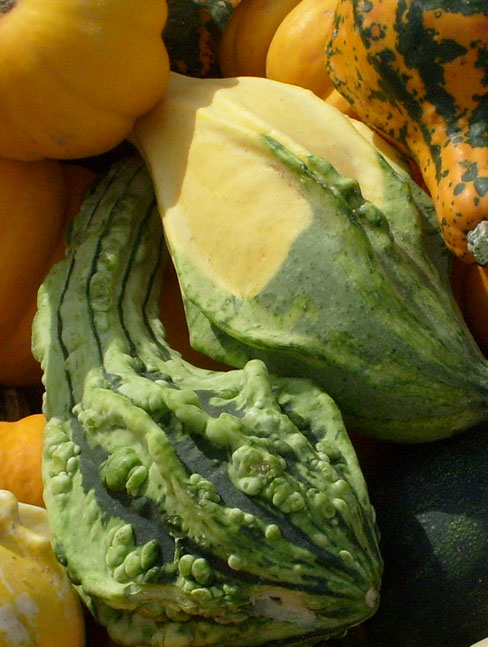Gourds
Gourds, which are related to pumpkins and squash, are generally grown for their hard outer rind. The fruit is dried for fall decorations, handicrafts and functional items. The various types of gourds include hard-shell gourds (Lagenaria spp.; used for dippers, containers and birdhouses), soft-shell gourds (Cucurbita pepo; decorative and ornamental uses), and luffa gourds (their soft interior fiber is used like a sponge).
Marketing
 Gourds can be marketed both wholesale and direct to the customer, and creative marketing can make many market channels possible for gourd growers. Common options are farmers markets, roadside and on-farm stands, festivals, craft fairs and specialty retail shops. Internet or mail order sales can expand a customer base beyond the local area, and some producers have used online auctions to sell gourds to crafters. Local health stores and specialty shops may be open to purchasing volumes of luffa sponges, sold as cosmetic and bath items. Ornamental gourds are frequently marketed during fall and winter months and can extend a farm’s marketing window. Some producers add value to gourd production by combining soft-shell gourds with pumpkins and ornamental corn for fall home and yard displays. Other producers decorate or craft hard-shell gourds during the winter and sell them throughout the following year at farmers markets, agritourism events, and other market outlets. Hard-shell gourds may also be sold to artisans and crafters year-round; although cleaning is labor intensive, properly cleaned hard-shell gourds can last indefinitely and be available for year-round sales.
Gourds can be marketed both wholesale and direct to the customer, and creative marketing can make many market channels possible for gourd growers. Common options are farmers markets, roadside and on-farm stands, festivals, craft fairs and specialty retail shops. Internet or mail order sales can expand a customer base beyond the local area, and some producers have used online auctions to sell gourds to crafters. Local health stores and specialty shops may be open to purchasing volumes of luffa sponges, sold as cosmetic and bath items. Ornamental gourds are frequently marketed during fall and winter months and can extend a farm’s marketing window. Some producers add value to gourd production by combining soft-shell gourds with pumpkins and ornamental corn for fall home and yard displays. Other producers decorate or craft hard-shell gourds during the winter and sell them throughout the following year at farmers markets, agritourism events, and other market outlets. Hard-shell gourds may also be sold to artisans and crafters year-round; although cleaning is labor intensive, properly cleaned hard-shell gourds can last indefinitely and be available for year-round sales.
Production
Select a sunny site with good air movement and well-drained, fertile soil. Sandy loam or clay loam soils high in organic matter are very desirable. Land should be selected that has not been planted in gourds, other cucurbits, peppers, tomatoes or tobacco for at least three years since these crops are susceptible to some of the same disease pathogens. The seedbed should be well-prepared by plowing deeply. Since seeds and plants are extremely sensitive to cold weather and wet soils, seeding should be delayed until after the frost-free date when the seedbed is warm and well drained. Because ornamental gourds are grown primarily for fall sales, the planting date should be based upon the days to maturity and desired harvest date.

